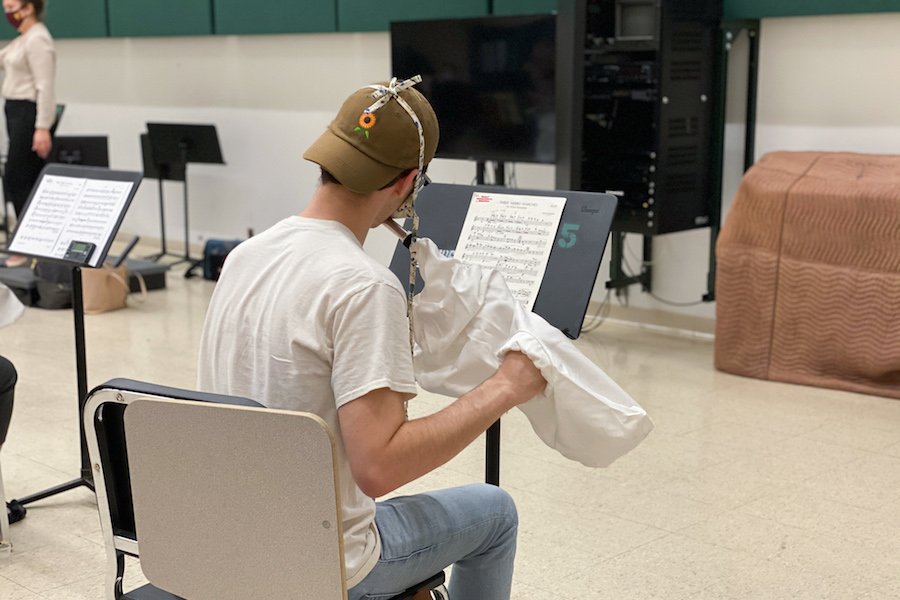Air purifiers help reduce virus spread in music classrooms

Above: A music student plays the flute using an instrument mask to limit the emission of potential virus-carrying aerosols.
Photo credit: Clancy Theade
CSE professor working with School of Music to make in-person instruction safer
January 14, 2021
Ventilation systems inside buildings have hardly been considered life-saving devices. But thanks to COVID-19, scientists are emphasizing the importance of good indoor air circulation and its role in mitigating the spread of the disease—especially while playing instruments or singing in a confined room.
College of Science and Engineering faculty member Suo Yang has found that the strategic placement of air purifiers can enhance that mitigation. And, he’s using that knowledge to help the University of Minnesota School of Music and facilitate in-person instruction safely.
Yang, the Richard and Barbara Assistant Professor in the Department of Mechanical Engineering, has been working with the music school since last fall.
School of Music director Michael Kim and facilities manager Peter Remiger were looking for ways to continue one-on-one classroom instruction and ensemble performances while keeping both students and teachers safe. After seeing Yang’s joint work with CSE faculty member Jiarong Hong on how virus aerosols spread indoors, they thought he might be able to help.
“School of Music curriculum and pedagogical interactions are grounded in one-on-one vocal and instrumental lessons,” Kim explained.
“Navigating the intricately unique complexities of each instrument, voice, artistic personality, and physical apparatus are an integral component of the student experience and producing world class musicians,” he said.
Using previous measurements from Hong’s study on aerosols released by musical instruments and data from other studies around the world, Yang and his team developed simulations to predict how the virus-containing particles would spread. They based their study on the layout of the studio practice rooms in Ferguson Hall. Their goal was to meet the World Health Organization (WHO) guideline of having a ventilation rate of least 288 cubic meters per hour, per person in a room.
“I think anyone who has learned a musical instrument knows that the most efficient way is one-to-one instruction—a big lecture room won’t be very useful,” Yang said. “The music school was wondering what possible approaches could be used to mitigate the risk. The best idea is ventilation, but if the ventilation is not enough, then we need to enhance the ventilation by adding air purifiers.”
The researchers found that by putting an air purifier in the direct flow path of the aerosol near where the air comes out of the instrument, one can reduce the number of potential virus aerosols being spread. If used this way, the air purifiers, along with the room’s original ventilation, can remove more than 99 percent of the virus particles in the air of the room.
Credit: Suo Yang, University of Minnesota
Yang advised the School of Music administrators to use portable air filters, placed directly in front of the instruments or the student who is singing. He also suggested taking 25-minute breaks between individual lessons to allow time for the ventilation to clean the air.
“Ventilation needs time,” Yang explained. “Normally, it would take more than 24 hours to reach 99 percent removal [of virus-containing particles]."
"But if you add a large enough purifier in the right location, it takes about 25 minutes. Then, you can have multiple sessions in one day and when the next session starts, it’s already pretty safe.”
Another important recommendation he offered: Place the purifier next to the person most at risk for having, and therefore spreading, COVID-19. If placed properly, the device will entrap the particles right away. But, if the purifier isn’t placed directly in line with the aerosols being exhaled, it could disrupt the natural air currents and exacerbate the spread. For instance, drawing them toward the other person.
The School of Music is already taking Yang’s advice into consideration.
The school has strategically placed air purifiers in every rehearsal space, enabling in-person instruction for music students and faculty, one-on-one applied lessons, and in-person rehearsals for chamber music, jazz and wind ensembles, and orchestras.
“We are incredibly grateful to Professor Yang and his team for their expertise and collaboration in the past semester, whose advice enabled us to deliver the safest possible educational experience to our music majors,” Kim said. “We feel most fortunate to be able to access these sorts of resources at one of the world’s leading research universities and look forward to more mutually beneficial collaborations with our fantastic colleagues in the College of Science and Engineering.”
Yang’s research goes beyond U of M music classrooms. He believes it can be applied to other indoor scenarios, as long as the WHO guideline for adequate ventilation rates are reached. In some buildings, for example, two air purifiers might be needed if the built-in ventilation isn’t strong enough.
“When the CDC made their guidelines, they didn’t mean it for a specific room—the guidelines are for any indoor environment, and we just tested their guidelines based on this scenario,” Yang said.
“I would say you only need to know two things,” he added, “the ventilation rate in your room from your heating, ventilation, and air conditioning (HVAC) system and the WHO guidelines to see how much ventilation you’re missing. Then, you can find the corresponding air purifier that will help you achieve the guideline criteria.”
Read more about the School of Music's COVID-19 protocol and safety measures.
To learn more about this work, read the research team’s paper, “Airborne Transmission of Virus-Laden Aerosols inside a Music Classroom: Effects of Portable Purifiers and Aerosol Injection Rates.”
Read about Professors Suo Yang and Jiarong Hong’s related aerosol study with the Minnesota Orchestra.
Story by Olivia Hultgren
